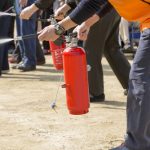The Importance of Regular Fire Drills
December 8, 2023 7:58 pm Leave your thoughts
Why Conduct Regular Fire Drills?
1. Promote Preparedness and Awareness:
Regular fire drills help individuals become familiar with evacuation routes, emergency exits, and assembly points. By practicing these procedures, individuals can develop muscle memory and respond instinctively in case of a real fire emergency. Fire drills also increase awareness about potential fire hazards and encourage people to adopt safe behaviors to prevent fires from occurring in the first place.
2. Test Emergency Response Plans:
Fire drills provide an opportunity to test the effectiveness of emergency response plans. By simulating a fire scenario, organizations can evaluate the efficiency of their evacuation procedures, determine any weaknesses or bottlenecks, and make necessary improvements. Regular drills allow for the identification and rectification of potential issues before an actual emergency occurs, ensuring a smoother and more effective response when it matters most.
3. Train Fire Wardens and Safety Teams:
In larger organizations or public spaces, fire drills help train fire wardens and safety teams responsible for guiding individuals during an evacuation. Regular drills allow these individuals to practice their roles and responsibilities, ensuring they are well-prepared to handle an emergency situation. Fire wardens and safety teams can also receive feedback and further training based on their performances during the drills.
Tips for Planning and Executing Effective Fire Drills:
1. Develop a Fire Escape Plan:
Begin by creating a comprehensive fire escape plan that includes designated evacuation routes, emergency exits, assembly points, and specific responsibilities for each individual or department. Consider the layout of the premises, the number of occupants, and any unique evacuation challenges. Communicate the escape plan clearly to all occupants, ensuring everyone understands their roles and the necessary actions to take during a fire drill.
2. Communicate and Educate:
Regularly communicate the importance of fire drills to all individuals in the organization or space. Explain the objectives of the drills, the procedures to be followed, and the expected behavior during the exercises. Conduct fire safety training sessions to educate people about fire hazards, fire prevention measures, and proper use of fire extinguishers, if applicable.
3. Schedule Regular Drills:
Set a schedule for regular fire drills, ensuring they are conducted at least annually or as required by local regulations. Consistency is key to ensuring individuals are adequately prepared. Consider conducting drills during different times of the day, including peak occupancy hours, to test response capabilities under various conditions.
4. Evaluate and Improve:
After each fire drill, conduct a thorough evaluation of the drill’s effectiveness. Consider feedback from participants, assess the time taken to evacuate the premises, and identify any areas that require improvement. Use this information to refine and update the fire escape plan, evacuation routes, or emergency procedures if necessary.
5. Promote Accountability and Participation:
Encourage active participation in fire drills by making them mandatory for all individuals. Emphasize the importance of taking drills seriously and following the instructions provided. Recognize and reward individuals who demonstrate exceptional performance or contributions during the drills, creating a positive culture of accountability and preparedness.
6. Involve Local Emergency Services:
Consider involving local fire departments or emergency services in the fire drills. They can provide guidance, support, and additional training during the drills. Collaborating with local authorities can further enhance the authenticity and effectiveness of the exercises.
Summary:
Regular fire drills are essential for promoting fire safety and preparedness in homes, businesses, and public spaces. They ensure individuals are familiar with evacuation procedures, emergency exits, and assembly points. Regular drills also facilitate the testing and improvement of emergency response plans. By planning and executing effective fire drills, organizations can enhance their overall fire safety protocols, protect lives, and minimize the potential damage caused by fires.
Need Fire Protection Systems in Longview, TX?
Welcome to Anchor Safety Inc.: the premier fire protection system and equipment provider of Longview, TX. Anchor Safety Inc. specializes in consultation, service, sales, and installation for fire protection systems for homes, offices, restaurants, computer server rooms, and document rooms. We carry and service all major brands, including Amerex, Ansul and Kidde. Anchor Safety Inc. is a member of FEDOT and the NAFED, as well as the Longview Chamber of Commerce. In business since 1990 with over 50 years of industry experience under our belts, you can trust in our expertise when it comes to fire safety. Give us a call for a free estimate or consultation for your fire safety.
Categorised in: Fire Safety and Escape Plans, Fire Safety Tips
This post was written by admin
